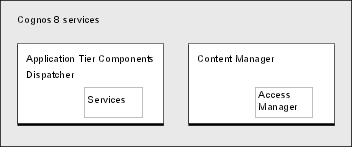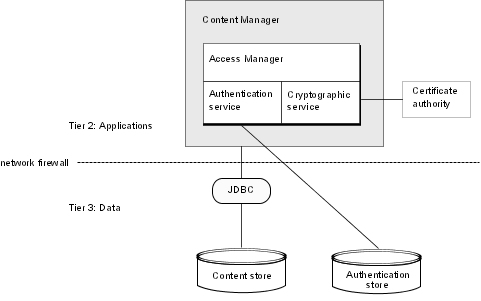Application Tier Components, which include
a dispatcher  ,
that operates services and routes requests
,
that operates services and routes requests
The Cognos 8 applications tier contains one or more Cognos 8 servers. A Cognos 8 server runs requests, such as reports, analyses, and queries, that are forwarded by a gateway. A Cognos 8 server also renders the Cognos Connection and Metric Studio interfaces.
Each Cognos 8 installation includes
Application Tier Components, which include
a dispatcher  ,
that operates services and routes requests
,
that operates services and routes requests

The dispatcher starts all Cognos 8 services configured and enabled on a computer, and routes requests. The dispatcher is a multithreaded application that uses one or more threads per request. Configuration changes are routinely communicated to all running dispatchers. The dispatcher includes Cognos Application Firewall to provide security for Cognos 8. For more information, see Cognos Application Firewall.
The dispatcher can route requests to a local service, such as the report service, presentation service, job service, or monitor service.
A dispatcher can also route requests to a specific dispatcher to run a given request. Requests can be routed to specific dispatchers based on load-balancing needs, or package or user group requirements. For example, if a particular OLAP data source is available for only one Cognos server group, you specify that all requests for the data source be routed to that Cognos server group. For more information about routing requests based on packages or user groups, see the Administration and Security Guide.
When you configure Cognos 8 gateways, you can list the universal resource identifiers (URIs) of target dispatchers in order of most to least preferred. If a dispatcher fails, requests are routed to another dispatcher based on the list. The primary dispatcher status is monitored by the gateway, and requests are routed back to this component when it returns to service. For more information, see the Installation and Configuration Guide.
When a dispatcher starts, it registers itself with Content Manager. As a result, each dispatcher is aware of the other dispatchers. If a dispatcher fails or is unavailable, requests for that dispatcher are routed to the next available dispatcher until the failed dispatcher reregisters itself.
After you install and configure Cognos 8, one dispatcher is available on each computer by default. Each dispatcher has a set of associated services, listed in the following table.
Service | Purpose |
Agent service | Runs agents. If the conditions for an agent are met when the agent runs, the agent service asks the monitor service to run the tasks. |
Batch report service | Manages background requests to run reports and provides output on behalf of the monitor service. |
Content Manager service |
|
Data movement service | Manages the execution of data movement tasks in Cognos 8. Data movement tasks, such as Builds and JobStreams, are created in Data Manager Designer and published to Cognos 8. |
Delivery service | Sends emails to an external SMTP server on behalf of other services, such as the report service, job service, agent service, or data integration service |
Event management service | Creates, schedules, and manages event objects that represent reports, jobs, agents, content store maintenance, deployment imports and exports, and metrics |
Job service | Runs jobs by signaling the monitor service to run job steps in the background. Steps include reports, other jobs, import, exports, and so on. |
Log service | Records log messages generated by the dispatcher and other services. The log service can be configured to record log information in a file, a database, a remote log server, Windows Event Viewer, or a UNIX system log. The log information can then be analyzed by customers or by Cognos Customer Support, including:
|
Metric Studio service | Provides the Metric Studio user interface for monitoring and entering performance information |
Migration service | Manages the migration from Cognos Series 7 to Cognos 8. |
Monitor service |
|
Planning job service | Manages communications with the Planning Job Server subsystem. |
Planning web service | Manages communications with Contributor Web and Contributor Add-in for Excel users. |
Planning administration console service | Manages communication with the Contributor Administration Console. |
Planning data service | Manages communications for real-time reporting from Contributor plan data in Cognos 8. |
Presentation service |
|
Report data service | Manages the transfer of report data between Cognos 8 and applications that consume the data, such as Cognos 8 Go! Office and Cognos 8 Go! Mobile. |
Report service | Manages interactive requests to run reports and provides output for a user in Cognos Connection or a studio |
System service | Defines the Business Intelligence Bus API-compliant service used to obtain application-wide Cognos 8 configuration parameters. It also provides methods that normalize and validate locale strings and map locale strings to locales supported by your application. |
Content Manager is the Cognos 8 service that manages the storage of customer application data, including security, configuration data, models, metrics, report specifications, and report output. Content Manager is needed to publish models, retrieve or store report specifications, manage scheduling information, and manage the Cognos namespace.
Content Manager stores information in a content store  database, which is
typically located in Tier 3 of the architecture.
database, which is
typically located in Tier 3 of the architecture.

Your installation may include more than one Content Manager, each on a different computer. One Content Manager computer is active and one or more Content Manager computers are on standby. The standby Content Manager computers are for failover protection. If the active Content Manager computer is not available because of a software or hardware failure, a standby Content Manager computer becomes active and requests are directed to it.
When the active Content Manager fails, unsaved session data is lost. When another Content Manager becomes active, users may be prompted to log on.
Although we describe Content Manager as part of the applications tier, for maximum security you can choose to configure Cognos 8 with Content Manager in the data tier.
The information stored by Content Manager includes
reports
Reports contain specifications, properties, security settings, and outputs. This includes analyses created in Analysis Studio, queries created in Query Studio, and reports created in Report Studio.
report packages
Packages contain metadata, reports, and folders.
metric packages
Metric packages contain metadata, scorecards, and folders.
agents
Agents include the conditions, schedules, and tasks used to monitor events and deliver notifications. This includes the list of recently detected instances of an event.
server configuration
Server configuration contains
directory information, the Cognos namespace  , and information
about contacts, distribution lists, data sources, and printers.
, and information
about contacts, distribution lists, data sources, and printers.
personal user information
Personal user information consists of My Folders and My Pages.
language information
Language information includes names, descriptions, and tool tips in different languages to support Cognos 8 multilingual capabilities.
Content Manager performs general functions, such as add, query, update, delete, move, and copy. It also performs content store management functions, such as export and import.
Content Manager contains Access Manager, the primary security
component of Cognos 8. Access Manager leverages your existing security
providers for use with Cognos 8. It provides Cognos 8 with a consistent
set of security capabilities and APIs, including user authentication  , authorization
, authorization  ,
and encryption
,
and encryption  . It also provides support for the Cognos namespace
. It also provides support for the Cognos namespace  .
.
Some security capabilities, such as user authentication, are external to Cognos 8 but are exposed to Cognos 8 by Access Manager. Other capabilities, such as authorization, are internal to Cognos 8, and are implemented by Access Manager.
For many security-related functions, Access Manager requires certificates, and interacts with a certificate authority. By default, Cognos 8 uses its own certificate authority service to establish the root of trust in the Cognos 8 security infrastructure. If you use a third-party certificate authority, you can configure Cognos 8 to use it instead of the default Cognos 8 certificate authority. For more information, see Security Architecture.
